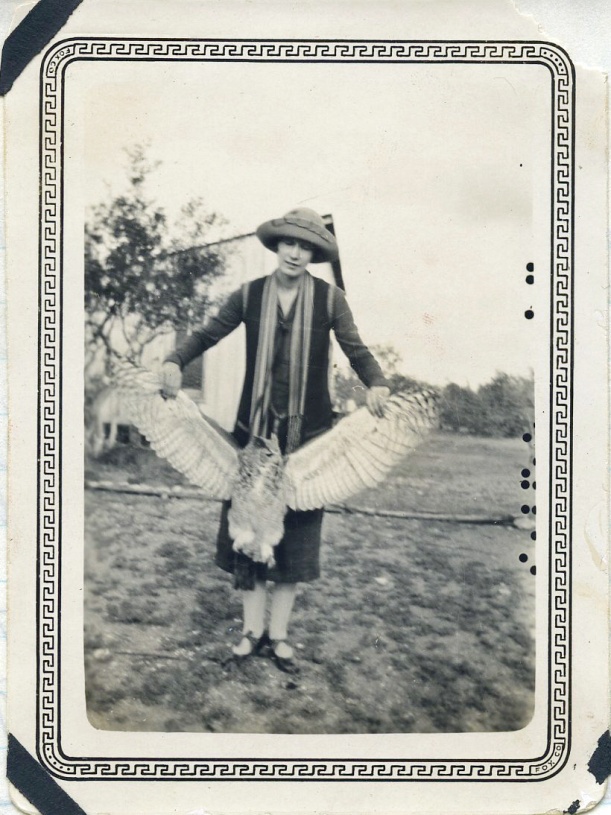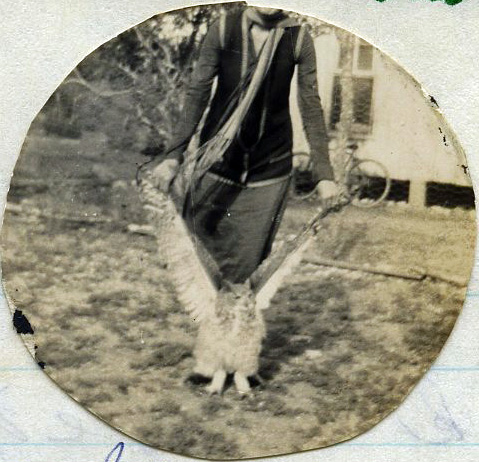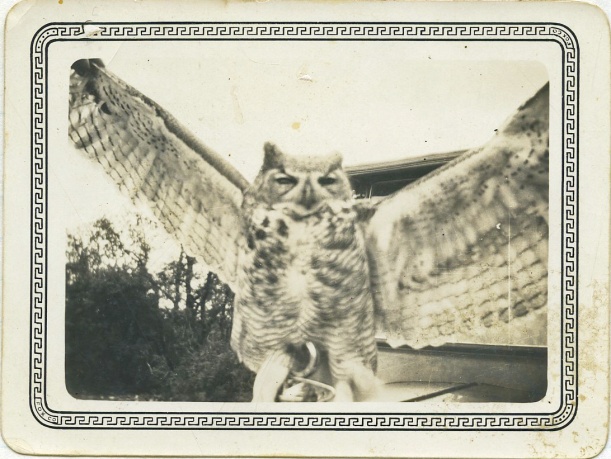About a year after Ray and I were married we spent six months or so on the “Six Mile Milam Ranch” so named because it was six miles from Uvalde. We were waiting for a Power Plant at Laredo to be built, where Ray was to be a Power Dispatcher.
Pop Milam and all the owners of the nearby ranches belonged to the Wolf Hunt Club. Once or twice a month they went on wolf hunts with trained wolf hounds. Coyotes had to be controlled as they could and would kill all the sheep, goats, calves, and deer – sometimes as many as twenty sheep or goats in one night.
On one of these wolf hunts they had killed a coyote, then discovered she had one lone pup, too young to survive alone. None of the men had the heart to kill it, because it came to them – being too young to be afraid.
They didn’t know what to do with it until Pop Milam remembered that I was a push-over for any stray animal! So they all agreed to bring it back to me, which they did, carrying it cuddled warmly inside the jacket of one of the hunters on horseback.
At the ranch, they all came trooping into the house, looking somewhat sheepish and trying to put on sad expressions on their faces. They kept looking at each other and finally Pop Milam said – with a great show of cheerfulness – “We brought you something!” Then the man pulled the coyote puppy out of his jacket and they all started telling me what a cute little fellow he was, and what a fine pet he would be for me, etc. (He was all ears and long legns) – I had my doubts about a pet coyote, remembering the experience my grandparents Saunders had with a neighbor’s pet coyote – I’ll tell you about that later.
One of the ranchers pointed out that this coyote pup was special as it had white feet – notice its feet in the picture. Sometimes coyotes mix with ranch dogs. So this coyote must really be part dog. One of the ranchers said if I would keep the coyote he would give me one of his purebred Scotch Border Collie puppies, it being about the same age as the coyote pup, to raise it with.
So, of course, I agreed to keep the coyote pup. And, true to his word, the next day the rancher rode up on horseback with the Border Collie puppy. Just before he left he told me the puppy wasn’t weaned yet!!
Well, I found myself bottle-feeding the coyote pup and the Border puppy. But they did fine, grew fast, and romped and played like all puppies do. Only Kazan liked to sleep most of the day, and stayed awake all night – that being the habit of coyotes. Scotty wanted to play by day and sleep all night. Kazan liked to stay in the house in the daytime and would seek out a dark place to hide and sleep. I soon learned never to touch him without waking him first as he would snap like lightning – the wild in him for self preservation, I guess, otherwise he was as tame and gentle as the puppy.
At night packs of coyotes would come close to the ranch house and howl, and Kazan would always prick up his ears and listen intently, but never answered them back. Scotty ignored them. They never came into the yard as we had two yard dogs, so they kept their distance.
When Kazan got a little older he wanted to stay outside at night, so I tied him in the yard, near the screened sleeping porch where we slept. The yard dogs – Buff and Duff – (they were that color) had accepted him when he first came to the ranch – with a somewhat puzzled look – they were trained to keep coyotes away – but here were these humans bringing one into their yard, and telling them it was alright!
Kazan played with Scotty, but when he tried to play with Buff or Duff, they would ignore him and if he persisted, they would get up with great boredom and sedately walk away.
As the Spring nights grew warmer, Scotty wanted to stay outside at night with Kazan, so one night I let him remain out in the yard. They were only a few feet from the sleeping porch where we slept. But in the middle of the night Kazan woke me with his immature “yapping” (coyotes don’t bark) and Scotty whining.
I thought perhaps Scotty was cold and wanted to come inside, so I got up in my nightgown and barefooted, and went out in the yard and brought Scotty in – and discovered a horrible thing had happened – he had been bitten by a rattlesnake. His head was swollen so large when he tried to walk he just fell over forward. And he was in great pain.
I woke Ray and he lit a lantern and went out and brought Kazan in and looked for the rattlesnake, but didn’t find it.
We didn’t know what to do. The only transportation we had was horseback, and it was 2:30 a.m. and the saddle horses were out to pasture. We were six miles from town. The only thing we had in the house to kill the pain was half a dozen aspirin tablets.
Scotty was crying so pitifully we just had to do something. We felt sure he would die. So we crushed two aspirin tablets in some sugar and milk and got that down his throat. That was an awfully big dose for a puppy, and in about 15 minutes he stopped crying and went limp. I guess the aspirin put him to sleep, or he just passed out. We knew rattlesnake bites were lanced, and decided to try it, as he was asleep or “out” and wouldn’t feel it. So Ray sharpened a razor blade and lanced an X on each of the fang punctures of the snake bite. Then we remembered that the vine growing all over the trellis on the front porch was a Maderia vine – grown and used by Mexicans as poultices to draw out infections, boils, etc. So we got some of the leaves and pounded them into a pulp and made poultices for the snake bite, changing them as they became soiled. About 4:a.m. we gave him two more aspirin as he had started to waken.
After daylight we left him and went and made coffee. I went back to him and put my hand on him to see if he was still breathing – and he feebly wagged his little white tipped tail!
In an hour or two he was trying to get up and walk! It really was “Oh! What a Beautiful Morning!”
For a few days we had to feed him with a spoon – his head was so swollen he could just barely open his mouth enough to insert the tip of a spoon. And for a week or so we kept his head bandaged – he looked for all the world like he had double mumps! And I had to keep Kazan away from him for fear he would hurt him playing. Kazan’s mouth was so big he could get most of Scotty’s head in it.
He fully recovered. But to this day I get chills when I remember how I walked out in that dark yard barefooted – and how lucky I was the snake didn’t bite me, too.
Later on a letter came saying the Power Plant was finished, so we packed up and went to Laredo to live. Later I’ll tell you about some experiences there. One was a strange one, and I wouldn’t dare tell it lest no one believe it, but, as it happened, the Milams and their neighbors on the next ranch knew about it, and were somewhat involved.
After we left the ranch, Pop and Myrt Milam moved back to take care of it. While we were living there, they were living in town. They kept us informed about Kazan and Scotty. Scotty grew up to be a fine stock dog. Herding the sheep and goats. And knew all the saddle horses and milk cows by name. They were kept in the “trap” which is a fenced enclosure around the ranch house and corrals of several acres. It would take days to find one of the saddle horses or milk cows if they were in the big pasture of thousands of acres!
Pop Milam said he could tell Scotty the horse or cow he wanted him to go bring in, and off he would go and bring it back, put it in the pen, then lie down in the gate so it couldn’t get out, until he came out and closed the gate.
Scotland Border Collies are black and white. In Scotland they have been trained for hundreds of years to herd sheep. They are very docile and friendly dogs, and very intelligent. Scotty’s parents were imported from Scotland.
But, sad to say, Kazan let his natural instincts overrule his better judgement one day and killed a chicken.
Pop Milam knew that once he had tasted the chicken, he would kill them again. So he took him about fifty miles away and turned him loose in the hills. Coyotes are not like dogs – they don’t have this homing instinct. Yet, he said when he heard coyotes howling at night, he was sure he heard Kazan’s voice. If so, he never came back to the ranch house.
In my next letter I’ll tell you about more happenings before we left the ranch.
-Nona
P.S. Later on the Milams sold this ranch and moved back to town. The man that bought the ranch insisted that Scotty stay with the ranch. Pop Milam knew that a town apartment would not be a happy place for a stock dog to live after being used to life on the ranch where he was raised and was home to him. So the rancher kept him and I never heard anymore of him.



